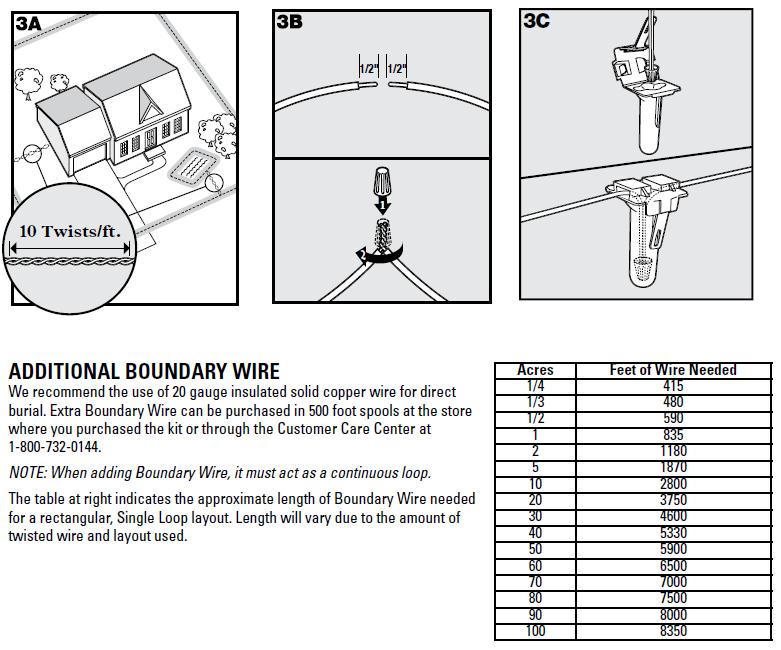Installation Step 3: Position the Boundary Wire
Lay out the Boundary Wire using your proposed boundary, and test the system BEFORE burying the wire or attaching it to an existing fence. This will make any layout changes easier. Work carefully, a nick in the wire insulation can diminish the signal strength and create a weak area where your dog can escape.
Running the Boundary Wire parallel to and within 1.5 metres of electrical wires, neighbouring containment systems, telephone wires, television or antenna cables, or satellite dishes will cause an inconsistent signal. If you must cross any of these, do so at 90-degree angles (perpendicularly). If separating your Boundary Wire by at least 1.5 metres from a neighbouring containment system’s wire does not reduce the inconsistent signal, contact us.
To Twist the Boundary Wire (3A)
Twisting the Boundary Wire cancels the signal and allows your dog to cross over that area without receiving a stimulation. To ensure the signal is cancelled, it is recommended that you cut and splice the Boundary Wire between each twisted section. The signal cannot be cancelled by running the wire through plastic or metal piping. Splicing shielded cable to the Boundary Wire will also not cancel the signal. Refer to figure on the right for the correct method for twisting the wire. You can twist your own wire by cutting two equal lengths of Boundary Wire supplied and twisting them together. Anchor one end of the wires to something secure and insert the other end in a power drill. Pull the wire taut. The drill enables you to twist the wire quickly. Twist the Boundary Wire 10 to 12 times 0.3 metres to cancel the signal. Once you have completed your boundary layout, insert the twisted wire into the transmitter. Twisted wire can be used to keep the pet out of a flowerbed, pool, etc. For the system to work properly, customers should not use more twisted wire than untwisted wire in their layout.
To Splice or Repair the Boundary Wire (3B)
If you need additional Boundary Wire to expand your wire loop, you will need to splice the wires together. Note the locations of all splices for future reference. Most Boundary Wire breaks occur at splices.
- Strip approximately 1.3 cm of insulation off the ends of the Boundary Wires to be spliced.
- Make sure the copper Boundary Wire is not corroded. If the Boundary Wire is corroded, cut it back to expose clean copper wire.
- Insert the stripped ends into the wire connector and twist the wire connector around the wires.
- Pull on the wires to make sure you have a strong splice connection. If your splice pulls loose, the entire system will fail. Make sure your splice is secure. For extra protection, Waterproof Wire Connector Covers have been included.
- Insert the splice and push the wire connector to the bottom, making sure the gel covers any exposed wire. Latch the Waterproof Wire Connector Cover securely (3C).

Driveways:
If the wire is going to cross a concrete driveway, place the wire in an expansion joint or in a groove that is cut using a circular saw, then cover the wire with an appropriate patching compound. If the wire is going to cross a gravel or dirt driveway, place the wire in PVC pipe or a garden hose to protect it from damage before burying it.
Underground Utility Lines:
Buried cables can cause interference with the containment system if not properly avoided. If the boundary wire is parallel to the cables, it should be kept far enough away that the signal will not reach the cable, usually at least 3 meters. If the boundary wire must cross cables, it should be done at a 90-degree angle.
Neighbouring Containment Systems:
Neighbouring containment systems can also cause interference. A neighbouring In-Ground Fence™ system must be avoided in the same way as a parallel utility line (keep far enough away that the signals do not overlap). If there is still interference, when the neighbouring system is properly avoided, we can suggest replacing the customer’s transmitter and receiver with an Innotek® system. Wireless fences can also interfere, and these systems should be installed so that the signals do not overlap one another.
Replacing Boundary Wire:
If you ever need to replace all of the boundary wire, you must remove all of the old boundary wire. Even though it is not plugged into anything, it can cause the same interference as an underground utility line or a neighbouring In-Ground Fence™ system.








